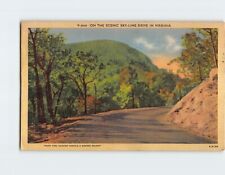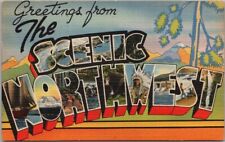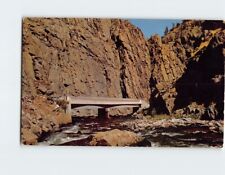|

On eBay Now...
The Scenic Northwest – Great Northern Railway, circa 1915 Travel Poster For Sale

When you click on links to various merchants on this site and make a purchase, this can result in this site earning a commission. Affiliate programs and affiliations include, but are not limited to, the eBay Partner Network.

The Scenic Northwest – Great Northern Railway, circa 1915 Travel Poster:
$19.95
These are simply the bestposters available! You will be thrilled with the image quality, vivid colors,fine paper, and unique subjects.Thisis an original image that has been transformed into a beautiful poster -available exclusively from Landis Publications. OUR POSTERS ARE SIZED FORSTANDARD OFF-THE-SHELF FRAMES, WITH NO CUSTOM FRAMING REQUIRED, PROVIDING HUGECOST SAVINGS! Thisbeautifulreproduction poster has been re-mastered from a circa 1915 advertising brochurefor the Great Northern Railway, featuring a locomotive piercing the RockyMountains. The vibrantcolors and detail of this classic image have been painstakingly brought back tolife to preserve a great piece of history. The high-resolution image is printed on heavy archival photopaper, on a large-format, professional giclée process printer. The poster isshipped in a rigid cardboard tube, and is ready for framing. The 13\"x19\" format is an excellentimage size that looks great as a stand-alone piece of art, or as a groupedvisual statement. These posters requireno cutting, trimming, or customframing, and a wide variety of 13\"x19\" frames are readilyavailable at your local craft or hobby retailer, and online. A great vintage print for your home, shop, orbusiness! GREAT NORTHERN RAILWAY HISTORY TheGreat Northern was built in stages, slowly to create profitable lines, beforeextending the road further into the undeveloped Western territories. In aseries of the earliest public relations campaigns, contests were held topromote interest in the railroad and the ranchlands along its route. Fred J.Adams used promotional incentives such as feed and seed donations to farmersgetting started along the line. Contests were all-inclusive, from largest farmanimals to largest freight carload capacity and were promoted heavily toimmigrants and newcomers from the East. Theearliest predecessor railroad to the GN was the St. Paul and Pacific Railroad,a bankrupt railroad with a small amount of track in the state of Minnesota.James Jerome Hill convinced John S. Kennedy (a New York banker), Norman Kittson(Hill\'s friend and a wealthy fur trader), Donald Smith (an executive withCanada\'s Hudson\'s Bay Company), George Stephen (Smith\'s cousin and president ofthe Bank of Montreal), and others to invest $5.5 million in purchasing therailroad. On March 13, 1878, the road\'s creditors formally signed an agreementtransferring their bonds and control of the railroad to Hill\'s investmentgroup. On September 18, 1889, Hill changed the name of the Minneapolis and St.Cloud Railway (a railroad which existed primarily on paper, but which held veryextensive land grants throughout the Midwest and Pacific Northwest) to theGreat Northern Railway. On February 1, 1890, he transferred ownership of theStPM&M, Montana Central Railway, and other rail systems he owned to theGreat Northern. TheGreat Northern had branches that ran north to the Canada–US border inMinnesota, North Dakota, and Montana. It also had branches that ran toSuperior, Wisconsin, and Butte, Montana, connecting with the iron mining fieldsof Minnesota and copper mines of Montana. In 1898 Hill purchased control oflarge parts of the Messabe Range iron mining district in Minnesota, along withits rail lines. The Great Northern began large-scale shipment of ore to thesteel mills of the Midwest. At its height, Great Northern operated over 8,000miles. Therailroad’s best-known engineer was John Frank Stevens, who served from 1889 to1903. Stevens was acclaimed for his 1889 exploration of Marias Pass in Montana anddetermined its practicability for a railroad. Stevens was an efficientadministrator with remarkable technical skills and imagination. He discoveredStevens Pass through the Cascade Mountains, set railroad construction standardsin the Mesabi Range of northern Minnesota, and supervised construction of theOregon Trunk Line. He then became the chief engineer of the Panama Canal. Thelogo of the railroad, a Rocky Mountain goat, was based on a goat WilliamKenney, one of the railroad\'s presidents, had used to haul newspapers as a boy. Themainline began at Saint Paul, Minnesota, heading west and topping the bluffs ofthe Mississippi River, crossing the river to Minneapolis on a massivemulti-piered stone bridge. The Stone Arch Bridge stands in Minneapolis, nearthe Saint Anthony Falls, the only waterfall on the Mississippi. The bridgeceased to be used as a railroad bridge in 1978 and is now used as a pedestrianriver crossing with excellent views of the falls and of the lock system used togrant barges access up the river past the falls. The mainline headed northwestfrom the Twin Cities, across North Dakota and eastern Montana. The line thencrossed the Rocky Mountains at Marias Pass, and then followed the FlatheadRiver and then Kootenai River to Athol, Idaho, and Spokane, Washington. Fromhere, the mainline crossed the Cascade Mountains through the Cascade Tunnelunder Stevens Pass, reaching Seattle, Washington, in 1893, with the driving ofthe last spike at Scenic, Washington, on January 6, 1893. Themain line west of Marias Pass has been relocated twice. The original route overHaskell Pass, via Kalispell and Marion, Montana was replaced in 1904 by a morecircuitous but flatter route via Whitefish and Eureka, joining the KootenaiRiver at Rexford, Montana. A further reroute was necessitated by theconstruction of the Libby Dam on the Kootenai River in the late 1960s. The ArmyCorp of Engineers built a new route through the Salish Mountains, including the7-mile-long Flathead Tunnel, second-longest in the United States, to relocatethe tracks away from the Kootenai River. This route opened in 1970. Thesurviving portions of the older routes (from Columbia Falls to Kalispell andStryker to Eureka, are now operated by Watco as the Mission Mountain Railroad. TheGreat Northern mainline crossed the continental divide through Marias Pass, thelowest crossing of the Rockies south of the Canada–US border. Here, themainline forms the southern border of Glacier National Park, which the GNpromoted heavily as a tourist attraction. GN constructed stations at EastGlacier and West Glacier entries to the park, stone and timber lodges at theentries and other inns and lodges throughout the Park. Many of the structureshave been listed on the National Register of Historic Places due to uniqueconstruction, location and the beauty of the surrounding regions. In1931 the GN also developed the \"Inside Gateway,\" a route toCalifornia that rivaled the Southern Pacific Railroad\'s route between Oregonand California. The GN route was further inland than the SP route and ran southfrom the Columbia River in Oregon. The GN connected with the Western Pacific atBieber, California; the Western Pacific connected with the Atchison, Topeka,and Santa Fe in Stockton, California, and together the three railroads (GN, WP,and ATSF) competed with Southern Pacific for traffic between California and thePacific Northwest. With a terminus at Superior, Wisconsin, the Great Northernwas able to provide transportation from the Pacific to the Atlantic by takingadvantage of the shorter distance to Duluth from the ocean, as compared toChicago. TheGreat Northern energetically promoted settlement along its lines in NorthDakota and Montana, especially by Germans and Scandinavians from Europe. TheGreat Northern bought its lands from the federal government – it received noland grants and resold them to farmers one by one. It operated agencies inGermany and Scandinavia that promoted its lands, and brought families over atlow cost, building special colonist cars to transport immigrant families. Therapidly increasing settlement in North Dakota\'s Red River Valley along theMinnesota border between 1871 and 1890 was a major example of large-scale\"bonanza\" farming. On March 2nd, 1970 the Great Northern,together with the Northern Pacific Railway, the Chicago, Burlington and QuincyRailroad and the Spokane, Portland and Seattle Railway merged to form theBurlington Northern Railroad. The BN operated until 1996, when it merged withthe Atchison, Topeka and Santa Fe Railway to form the Burlington Northern andSanta Fe Railway.


Look Out for Train 7 - To the Scenic Rim (1) $23.58

Vintage "The Scenic NORTHWEST" Large Letter Postcard Kropp Linen c1940s Unused $5.99

Postcard On The Scenic Skyline Drive Virginia USA $20.97

c1940s "Greetings from the SCENIC NORTHWEST" Large Letter Postcard Portland OR $5.99

Greetings From The Scenic Northwest ~ LARGE LETTER ~ unposted linen postcard $5.75

GA~GEORGIA~AUGUSTA~HENRY STREET~ALONG THE SCENIC TRAIL~CONTINENTAL $2.99

Purse Seining in the Scenic Pacific Northwest, Ship, Vintage Postcard $7.99

Postcard The Scenic Narrows Big Thompson Canyon Colorado USA North America $9.09
|